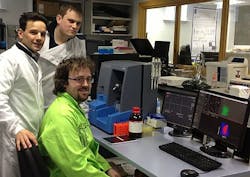Nanoparticle tracking analysis has utility in developing future cancer solutions
Scientists at the School of Medicine and the Centre for Research on Adaptive Nanostructures and Nanodevices (CRANN) at Trinity College Dublin in Ireland are using nanoparticle tracking analysis (NTA)âa laser-based measurement techniqueâto develop future diagnostic and theranostic solutions for early diagnosis, drug delivery, and treatment of cancer.
Related: Laser-enabled nanoparticle quantification aids metastasis research
Related: Nanoparticle tracking analysis characterizes vaccines
Dr. Adriele Prina-Mello, a Research Fellow at CRANN and a part-time lecturer at the School of Medicine, is focusing on functional biomaterials, diagnostic devices, and multifunctional nanomaterials for theranostic solutions in the treatment of cancer. Fundamental in his work is the understanding of particle size, size distribution, and of hydrodynamic response of nanoparticles dependent on their degree of aggregation. Also, the ability to measure zeta potential and track particle behavior in viscous or physiologically relevant media addresses the demands of the nanomedicine community, where comprehensive, low-volume testing of sometimes very "expensive" samples is needed.
"Our main motivation for such levels of characterization is determined by the potential use, applicability, and safety aspect linked to nanosize materials," explains Prina-Mello. "This allows for further modification of the particle surface coating/moieties in order to get closer to the suitable candidate for diagnostic, monitoring, and therapeutic application for nanomedicine and/or biomedical research and also clinical translation. Furthermore, we also need characterization information as basic preliminary understanding in order to address wider experimental screening based on pharmaceutical standards necessary to identify potential nanoparticle as lead carrier candidates for drug delivery of therapeutics."
The NTA instrumentation (the NS500 system from NanoSight [Salisbury, England]) being used in the researchers' work enables identification of heterogeneity in particle size, poly-dispersity, and counting, with simultaneous zeta potential measurement, says Prina-Mello.
-----
Follow us on Twitter, 'like' us on Facebook, and join our group on LinkedIn
Subscribe now to BioOptics World magazine; it's free!

